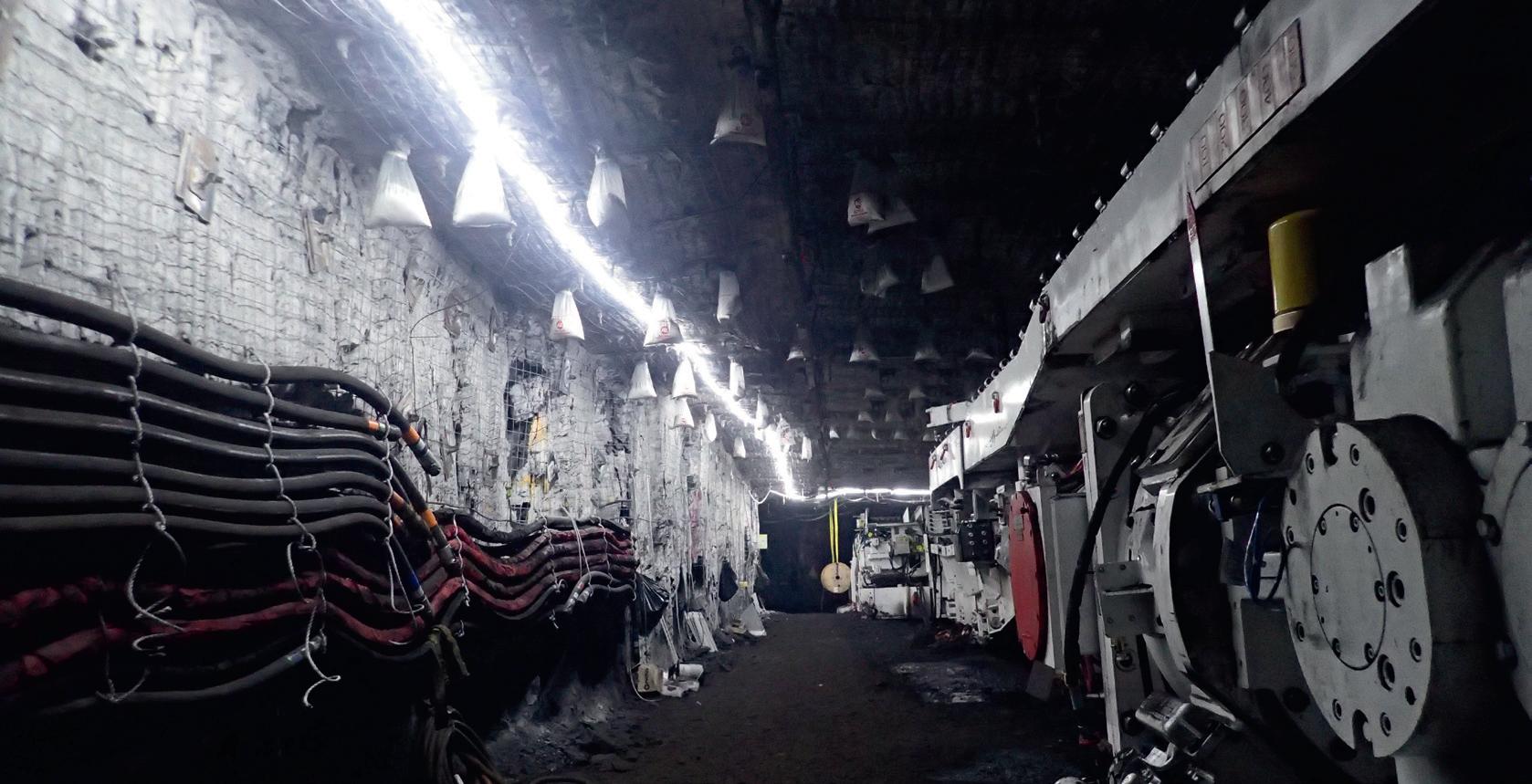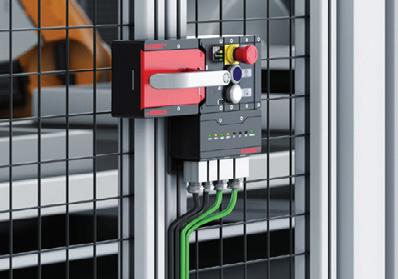
10 minute read
Mining case studies — apps, lights, sensors and retrofits
MINING CASE STUDIES
APPS, LIGHTS, SENSORS & RETROFITS
In this mining case studies feature we take a look at four solutions that are using technology to improve safety in Aussie mines: an industry app intended to support mental health and resilience; strip lights specially designed for environments such as underground mines, where fire or explosion hazards exist due to flammable gases or explosive substances; the work of a mechanical engineer, who has designed sensors that can detect early mechanical issues in oil and gas pipelines, making working conditions safer for miners; and an electric vehicle retrofit geared towards driving down the dangers of diesel particulate matter in our underground mines.
CASE
STUDY New app prioritises mental wellbeing, safety of miners
Mental health is central to health and safety, as mental health problems can have an adverse impact on mining workers, their families and industry productivity. Australia’s minerals industry has taken steps to support the mental health and resilience of its workforce with the launch of the free MineWell mobile app, developed by miners for miners, to reduce stress and improve wellbeing. The launch of the MineWell app is a step forward in making help available to mining workers and their families who may be going through a tough time because of long hours, separation, isolation or financial stress. Many fly-in fly-out (FIFO) workers have also been affected by the COVID-19 pandemic, which has resulted in longer shifts and more time away from family and friends.
The Minerals Council of Australia (MCA) and its partners have worked over many years to build industry understanding and capacity through the Blueprint for Mental Health and Wellbeing industry guide. Australia’s mining industry is delivering a range of programs that promote mental health and wellbeing, prevent problems, and provide an effective and early response as part of an integrated approach within overall health and safety policy and practice. This includes MineWell, a preventative mental health and wellbeing app developed by the MCA and Utility Creative to provide prevention, intervention and education in mental health and wellbeing for Australian mining workers and their families.
The app includes a range of features, including personalised scheduling for shift workers to promote better sleep and alertness whilst on shift. The app also provides advice and exercises for improving sleep quality, staying active and positive, and staying well during the COVID-19 pandemic. The
©stock.adobe.com/au/Kings Access app features tools that help users take control through breathing, taking a reality check, managing emotions and releasing tension. A social connection tool also helps users schedule anniversaries, birthdays, catch-ups and other important events.
The app includes a crisis response tool for direct calls to MATES in Mining, Lifeline, Beyond Blue and other help services. A Budget Well feature helps users set a target budget and savings goals, while helping to track progress to reduce anxiety relating to financial management. MineWell was developed based on feedback from focus groups and user testing by Australian miners and is available free to all mine workers and their families through the Apple App Store and Google Play. All personal information provided by app users remains private, is only stored on the user’s device and cannot be accessed or gathered by others. Minerals Council of Australia www.minerals.org.au
CASE
STUDY Explosive-proof LED strip lights the way in hazardous areas
©Mineglow
Hazardous area LED strip light specialist and trading partner of x-Glo Lighting, Mineglow, has launched IECEx certified explosive-proof LED strip lights in Oceania. The x-Glo IECEx range is designed to reduce the risk of explosions in gas and oil rigs, coalmines and other industrial applications, being purpose-built for environments where fire or explosion hazards exist due to flammable gases or explosive substances such as vapours, mists or dusts. The LED strip light solution provides protection by encapsulating electrical ignitions inside the light. Mineglow General Manager Carinne Pater said the IECEx certified lighting improves health and safety by protecting workers from the risk of accidental ignitions of flammable or explosive materials. Pater noted that the best way to prevent explosions in high-risk industrial areas is to remove potential ignition sources, adding that lights are some of the most common causes of explosion ignition.
“Our solution minimises risk by isolating and containing sparks within the strip to prevent explosions from escaping and potentially igniting the gases and particles in the atmosphere. The low profile of our lighting solution also means that they can’t be knocked and shatter. This greatly minimises the risk of an explosive reaction from spreading or igniting volatile substances in the area, so in terms of health and safety — the benefits are significant,” Pater said. An underground coalmine in Australia, offshore floating production storage and loading unit in Western Australia and a paint manufacturing plant in New South Wales have all adopted Mineglow’s x-Glo explosive-proof LED strip lights. In doing so, they have increased their operational efficiency and workplace safety, while reducing maintenance and operating costs.
The x-Glo LED solution is IECEx, ATEX and RoHS approved and certified for gas zones one and two, and dust zones 21 and 22. The lights are encapsulated with silicone, making them resistant to dust, humidity, chemicals and extreme environmental temperatures without enabling the risk of explosion. The LED-strip design also offers benefits over conventional lighting, due to its flexibility, efficiency, durability and ease of deployment.
“This range is unique as it combines IECEx certified protection and peace of mind with all the benefits of premium, industrial-grade LED strip lighting. Beyond energy efficiency alone, industrial-grade LED strip lighting is renowned for its flexibility to install quickly and easily in hard-to-reach places, is fully customisable in length and requires zero maintenance,” Pater said. Due to their flexibility, the lights are easy to install and can be mounted to any surface, including curved surfaces and corners, to provide consistent lighting to illuminate large areas. A single strip of lighting runs up to 30 metres and can be powered with 24, 36 or 48 V (AC or DC), giving customers the option to choose the level of illumination for their application.
Mineglow’s range has a 50,000-hour lifespan and can provide a daylight spectrum light in white 6500K for continuous lighting in hazardous areas and red, amber and green for emergency directional lighting for illuminating escape routes. Pater said LED explosion-proof lighting solutions are becoming a safer, more cost-efficient solution to alternative complex lighting infrastructures, particularly in the Asia–Pacific region.
“With the increasing regulations on worker safety globally, we’re seeing a lot of growth in the explosive-proof lighting market. It’s fantastic that we can provide a flexible LED strip lighting solution that’s truly unique and purpose-built for harsh conditions,” Pater said. Pater added that the replacement of incandescent and compact fluorescent lamps continues to grow with the improvement of diode technology that aids higher power LEDs with higher lumen output. “Using high-quality SMD LED chips, our explosive-proof range offers high brightness, colour consistency, uniformity and most importantly, high reliability,” Pater said. Mineglow www.mineglow.com.au

CASE
STUDY ‘Super’ sensors to make conditions safer for miners
Dr Toan Dinh, a mechanical engineer at the University of Southern Queensland, has designed sensors to help prevent injury and death on mining sites by detecting early mechanical issues in oil and gas pipelines. The sensors, made of silicon carbide, can withstand harsh and corrosive environments, and are five to 100 times smaller than the width of a single human hair. Dr Dinh spent six years developing the sensors, which perform a thousand times better than conventional sensors. Dr Dinh explained that current silicon technology can’t be used in harsh environments, because it cannot survive a long time in conditions of high temperatures and corrosion.
“The sensors I have developed can operate in up to 600°C for a wide range of applications, including oil and gas industries and aerospace technologies,” Dr Dinh said. Oil and gas exploration and production sites can be dangerous workplaces, due to the risk of fires and explosions. Dr Dinh said his sensors can help detect and measure the tiniest of movements in the environment, and monitor in real time the structural health of a system, such as a pipeline, in case there are any changes or faults. “It is critically important we make working conditions safer for miners and more efficient,” Dr Dinh said. “This can help prevent a major system failure from occurring, not only reducing maintenance costs but potentially avert a catastrophic situation that could lead to injury or death.”
Dr Dinh recently received a $440,675 grant under the Australian Research Council (ARC) Discovery Early Career Researcher Award scheme to further develop his research. The grant will enable him to travel to California, where he will collaborate with researchers at NASA’s Jet Propulsion Laboratory to analyse how the sensors could be used in space exploration. “It’s a very exciting opportunity and a great chance to focus on improving the technology’s performance so it can operate in more environments and applications. My goal is to start testing the sensors in real industry conditions as early as this year before they are ready for commercialisation,” Dr Dinh said. The ARC Discovery Early Career Researcher Award scheme provides support for researchers and creates opportunities for early-career researchers in teaching, research and research-only positions in Australia.

©stock.adobe.com/au/Michael Evans
University of Southern Queensland www.usq.edu.au

CASE
STUDY Electric vehicle retrofit clears the air in underground mining
The TRITEV, an underground mine electric vehicle (EV), was showcased late last year in Newcastle in New South Wales’ Hunter Valley and was believed to be the first fully battery electric retrofit 20-tonne loader suitable for deployment into underground hard rock mines, developed in Australia for the mining industry. The fully operational TRITEV prototype was designed through a collaboration between 3ME Technology and Batt Mobile Equipment, as a successful shift away from diesel run-vehicles, for Aeris Resources. With the TRITEV now complete, 3ME Technology believes the platform will help the drive to decarbonise and eliminate the issue of diesel particulate matter underground, while saving on the high OPEX costs associated with mine shaft ventilation and the running of an ageing diesel fleet.
The electric vehicle has been developed under the METS Ignited Collaborative Project Funds, which bring together Australian METS companies, global suppliers, mine operators, research organisations and capital providers to support and improve productivity and innovative capacity of Australia’s mining equipment, technology and services (METS) sector. 3ME Technology CEO Justin Bain said the TRITEV is a result of a heavily collaborative effort with Batt Mobile Equipment, adding that 3ME is now in a position to replicate these models at scale. “It’s been an absolute pleasure working with the team at Batt Mobile Equipment,” Bain said. “Their industry knowledge, vehicle design expertise and mechanical acumen is second to none.”
METS Ignited CEO Adrian Beer said the Newcastle showcase highlighted the capability of Australia’s METS sector to improve sustainable mining practices. “METS Ignited Industry Growth Centre is pleased to support the commercialisation of technologies enabling safety improvements for Australia’s mining industry and potential global partners,” Beer said. 3ME Technology COO Martin Kime said the TRITEV has received interest from the underground mining industry in the battery electric retrofit of existing platforms.
Kime believes the interest is driven by the recognition that there is a need to remove diesel particulate matter underground. “Given the demand, we look forward to bringing jobs to the Hunter, helping with the COVID recovery whilst creating nextgeneration, clean battery technology!” Kime said. With a range of additional mining vehicles ready to be electrified, it is anticipated that the 3ME Technology and Batt Mobile Equipment partnership will continue with its quest to electrify underground mining to increase the standards of work health and safety for miners and benefit the environment.

©stock.adobe.com/au/Mariana Ianovska
3ME Technology www.3metech.com


Safety gate locks Vision sensors Safety relays




WE OFFER A WIDE RANGE OF WORLD-CLASS SAFETY PRODUCTS!
1300 65 75 64 www.treotham.com.au info@treotham.com.au Australian Owned & Managed







